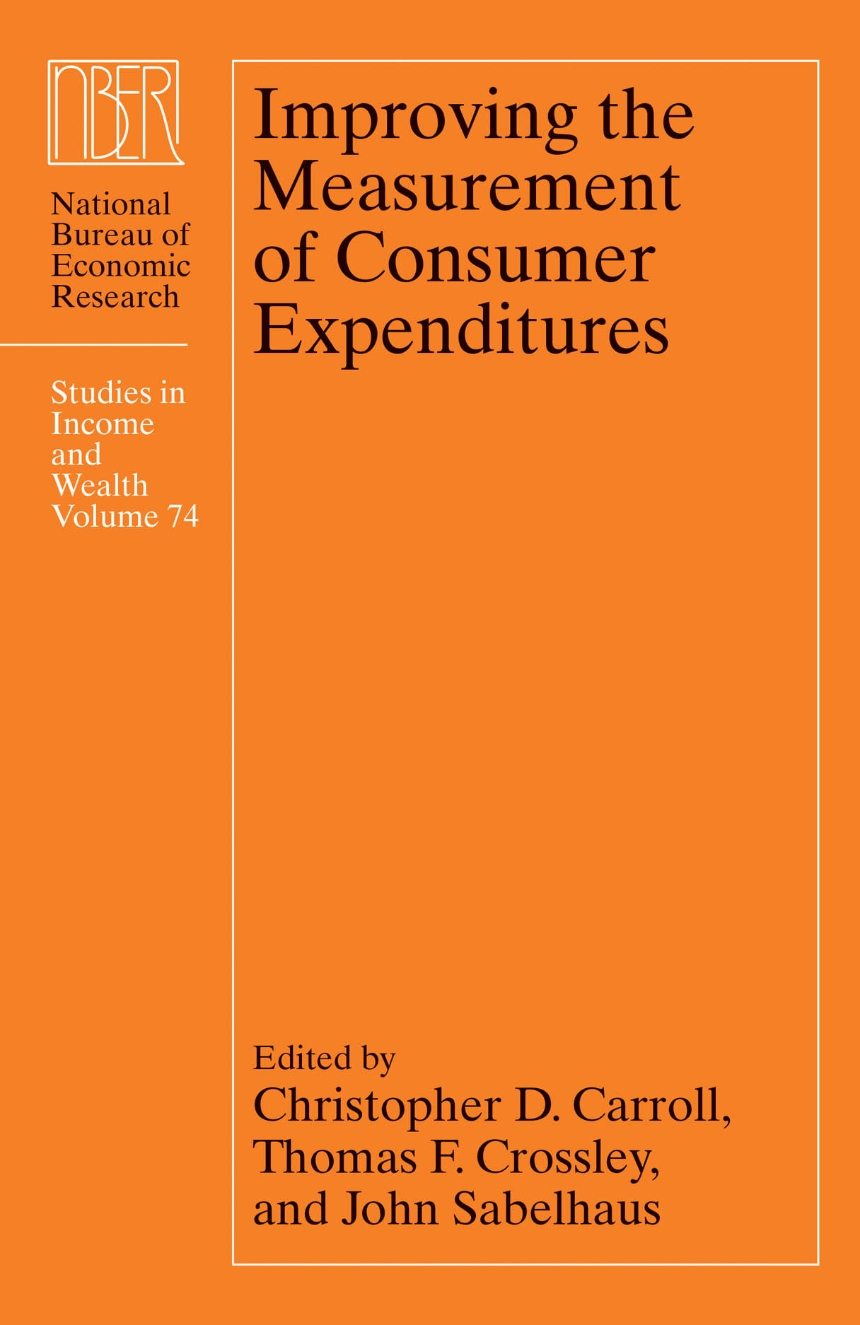Improving the Measurement of Consumer Expenditures
Robust and reliable measures of consumer expenditures are essential for analyzing aggregate economic activity and for measuring differences in household circumstances. Many countries, including the United States, are embarking on ambitious projects to redesign surveys of consumer expenditures, with the goal of better capturing economic heterogeneity. This is an appropriate time to examine the way consumer expenditures are currently measured, and the challenges and opportunities that alternative approaches might present.
Improving the Measurement of Consumer Expenditures begins with a comprehensive review of current methodologies for collecting consumer expenditure data. Subsequent chapters highlight the range of different objectives that expenditure surveys may satisfy, compare the data available from consumer expenditure surveys with that available from other sources, and describe how the United States’s current survey practices compare with those in other nations.
Improving the Measurement of Consumer Expenditures begins with a comprehensive review of current methodologies for collecting consumer expenditure data. Subsequent chapters highlight the range of different objectives that expenditure surveys may satisfy, compare the data available from consumer expenditure surveys with that available from other sources, and describe how the United States’s current survey practices compare with those in other nations.
528 pages | 2 halftones, 97 line drawings, 117 tables | 6 x 9 | © 2015
National Bureau of Economic Research Studies in Income and Wealth
Economics and Business: Business--Industry and Labor, Economics--Econometrics and Statistics, Economics--International and Comparative, Economics--Money and Banking
Table of Contents
Prefatory Note
Introduction
Christopher D. Carroll, Thomas F. Crossley, and John Sabelhaus
I. What Do We Already Know about Collecting Household Expenditure Data?
1. Asking Households about Expenditures: What Have We Learned?
Thomas F. Crossley and Joachim K. Winter
II. Goals for the Expenditure Survey Redesign
2. Constructing a PCE-Weighted Consumer Price Index
Caitlin Blair
3. The Benefits of Panel Data in Consumer Expenditure Surveys
Jonathan A. Parker, Nicholas S. Souleles, and Christopher D. Carroll
4. The Evolution of Income, Consumption, and Leisure Inequality in the United States, 1980?2010
Orazio Attanasio, Erik Hurst, and Luigi Pistaferri
5. Using the CE to Model Household Demand
Laura Blow, Valérie Lechene, and Peter Levell
III. Evaluating the Existing CE Survey
6. Understanding the Relationship: CE Survey and PCE
William Passero, Thesia I. Garner, and Clinton McCully
7. The Validity of Consumption Data: Are the Consumer Expenditure Interview and Diary Surveys Informative?
Adam Bee, Bruce D. Meyer, and James X. Sullivan
8. Is the Consumer Expenditure Survey Representative by Income?
John Sabelhaus, David Johnson, Stephen Ash, David Swanson, Thesia I. Garner, John Greenlees, and Steve Henderson
9. A Comparison of Micro and Macro Expenditure Measures across Countries Using Differing Survey Methods
Garry Barrett, Peter Levell, and Kevin Milligan
IV. Alternative Approaches to Data Collection
10. Measuring the Accuracy of Survey Responses Using Administrative Register Data: Evidence from Denmark
Claus Thustrup Kreiner, David Dreyer Lassen, and Søren Leth-Petersen
11. Judging the Quality of Survey Data by Comparison with “Truth” as Measured by Administrative Records: Evidence from Sweden
Ralph Koijen, Stijn Van Nieuwerburgh, and Roine Vestman
12. Exploring a Balance Edit Approach in the Consumer Expenditure Quarterly Interview Survey
Scott Fricker, Brandon Kopp, and Nhien To
13. Measuring Total Household Spending in a Monthly Internet Survey: Evidence from the American Life Panel
Michael D. Hurd and Susann Rohwedder
14. Wealth Dynamics and Active Saving at Older Ages
Michael D. Hurd and Susann Rohwedder
15. Measuring Household Spending and Payment Habits: The Role of “Typical” and “Specific” Time Frames in Survey Questions
Marco Angrisani, Arie Kapteyn, and Scott Schuh
16. The Potential Use of In-Home Scanner Technology for Budget Surveys
Andrew Leicester
List of Contributors
Author Index
Subject Index
Introduction
Christopher D. Carroll, Thomas F. Crossley, and John Sabelhaus
I. What Do We Already Know about Collecting Household Expenditure Data?
1. Asking Households about Expenditures: What Have We Learned?
Thomas F. Crossley and Joachim K. Winter
II. Goals for the Expenditure Survey Redesign
2. Constructing a PCE-Weighted Consumer Price Index
Caitlin Blair
3. The Benefits of Panel Data in Consumer Expenditure Surveys
Jonathan A. Parker, Nicholas S. Souleles, and Christopher D. Carroll
4. The Evolution of Income, Consumption, and Leisure Inequality in the United States, 1980?2010
Orazio Attanasio, Erik Hurst, and Luigi Pistaferri
5. Using the CE to Model Household Demand
Laura Blow, Valérie Lechene, and Peter Levell
III. Evaluating the Existing CE Survey
6. Understanding the Relationship: CE Survey and PCE
William Passero, Thesia I. Garner, and Clinton McCully
7. The Validity of Consumption Data: Are the Consumer Expenditure Interview and Diary Surveys Informative?
Adam Bee, Bruce D. Meyer, and James X. Sullivan
8. Is the Consumer Expenditure Survey Representative by Income?
John Sabelhaus, David Johnson, Stephen Ash, David Swanson, Thesia I. Garner, John Greenlees, and Steve Henderson
9. A Comparison of Micro and Macro Expenditure Measures across Countries Using Differing Survey Methods
Garry Barrett, Peter Levell, and Kevin Milligan
IV. Alternative Approaches to Data Collection
10. Measuring the Accuracy of Survey Responses Using Administrative Register Data: Evidence from Denmark
Claus Thustrup Kreiner, David Dreyer Lassen, and Søren Leth-Petersen
11. Judging the Quality of Survey Data by Comparison with “Truth” as Measured by Administrative Records: Evidence from Sweden
Ralph Koijen, Stijn Van Nieuwerburgh, and Roine Vestman
12. Exploring a Balance Edit Approach in the Consumer Expenditure Quarterly Interview Survey
Scott Fricker, Brandon Kopp, and Nhien To
13. Measuring Total Household Spending in a Monthly Internet Survey: Evidence from the American Life Panel
Michael D. Hurd and Susann Rohwedder
14. Wealth Dynamics and Active Saving at Older Ages
Michael D. Hurd and Susann Rohwedder
15. Measuring Household Spending and Payment Habits: The Role of “Typical” and “Specific” Time Frames in Survey Questions
Marco Angrisani, Arie Kapteyn, and Scott Schuh
16. The Potential Use of In-Home Scanner Technology for Budget Surveys
Andrew Leicester
List of Contributors
Author Index
Subject Index
